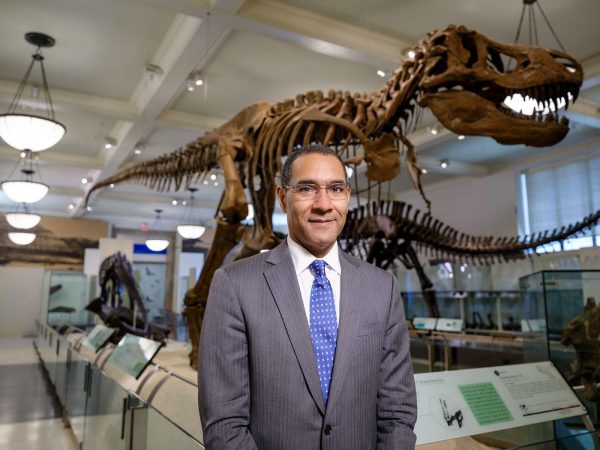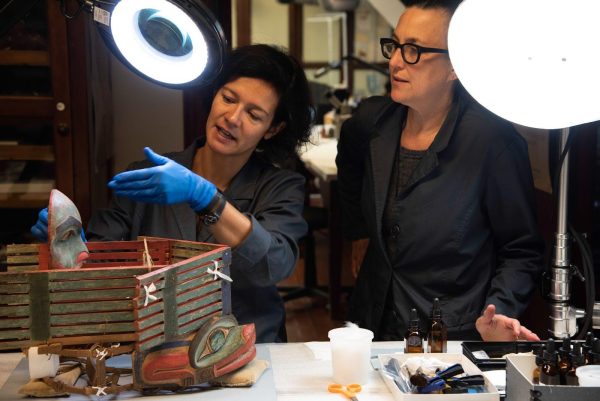Back in October 2023, the American Museum of Natural History (AMNH) announced a plan to renew the approach to their human remains stewardship. Since then, fellow museums across the world have kept their eye on this Upper West Side institution, waiting in anticipation to see how the museum that holds some of the largest natural history collections would go about this unprecedented change.
The museum’s public statement, written in the form of a letter to the museum staff from the institution’s new president, Dr. Sean Decatur, was filled with broad statements establishing the institution’s commitment to a more ethical future with their historical collections. Decatur’s letter reads, “It is our responsibility to develop a new ethical framework for our urgent work in this area, to study the history of the Museum, and step by step, to begin making concrete changes.”
While certainly a shift in the right direction, it left many to wonder what step-by-step changes the museum was actually taking towards repatriating the 12,000 skeletal remains currently housed in the AMNH, many of Native American origin.

In the initial statement given by President Decatur, he tackled the “complex legacy of the human remains collection” with two primary steps to be taken: removing human remains from current exhibits in twelve display cases and preparing new storage housing for the collections. Given the lack of consent from groups in which these remains belong to, the current collections were only made possible by historical discrepancies in power — a situation that the museum is trying to set right.
Through a conversation with Dr. Decatur, I gained insight into what the museum has been doing in the months since their initial statement addressing these disparities in museum collections, research, and consent.
Historically, museums have collected human remains in order to complete pseudo-scientific research, conducted to prove that marginalized groups were physiologically different from white, Anglo-Saxon populations. This hypothesis — fairly common through the early 20th century — was researched by taking detailed measurements of skeletons and the remains of individuals of different races.
Taking this into account, it is not surprising that the groups whose ancestors are currently held in collections did not consent to the research historically conducted — a challenge that the museum is now addressing. The absence of consent from many communities is ultimately what the primary concern of current museum administrators boils down to.
“Whether it is scientific questions that are advancing and improving our lives, such as medical research or questions that were deeply problematic regarding systems of racial hierarchy, the ethical standard for doing research involving people is consent,” President Decatur said, during the course of my interview with him. “You don’t do research, certainly not on people, without their consent to participate in this research.”
While the international debate on the ethical nature of human remains has a recurring argument that the educational potential of these remains overpowers any moral concerns, the leadership at AMNH believes the balance needs to skew in the opposite direction. “The overwhelming majority of our ancestral remains were obtained without consent,” said Dr. Decatur. “Given this, can we say that the advances in science being done are enough to override the ethical concerns of using individuals’ bodies without consent? From my perspective, absolutely not.”
The legal framework governing how museums should approach Native American human remains and funerary objects dates back to 1990 with the passing of NAGPRA — the Native American Graves Protection and Repatriation Act — which governs objects of “cultural patrimony” to Native American groups. The original act had a goal of returning culturally significant objects to North American tribes and stated that all collections from North American native communities had to have inventories published, so that Native American tribes could begin the process of returning to their communities any sacred objects or remains that they wish to preserve. In 2023, however, NAGPRA underwent an expansion of the original act, adding on to many expansions over the years, claiming that all human remains and associated funerary objects were required to have clear consent from the associated group or community in order to be researched or held by museum institutions.
Several months before, in October of 2022, Dr. Decatur released a letter addressing the museum’s own shift in institutional collection policies, including a new stance on repatriation procedures on funerary objects and human remains. Once NAGPRA’s expansion was announced, the museum established their proactivity to comply in a moral manner, officially closing the Eastern Woodlands and Great Plains halls that demonstrated the unethical practices of the institution’s past.
“We’ve taken steps to close the halls while we continue to remove items from display and undergo the process of getting permission from tribes regarding the return of items or continuation of access here at AMNH,” said Dr. Decatur. The museum has already shut down two major halls dedicated to Indigenous cultures of North America — the Eastern Woodlands and Great Plains Hall — to visitors and staff.
The museum’s Northwest Coast Hall, which was recently renovated and reopened to the public in the Spring of 2022, is a primary example of the actions being taken by AMNH to hold and display culturally significant artifacts through extensive consultations with Indigenous groups.
Since the renovation, the hall features exhibits covering ten Native Nations of the Pacific Northwest, with more than 1,000 cultural objects, many of which are from North American indigenous groups. However, the hall also includes collections from international groups that do not fall under NAGPRA. Given this fact, the museum has taken the continuous position that the “same rights and responsibilities that we have from an ethical standpoint under NAGPRA should be focused towards groups that are not under NAGPRA, because they’re from a different country,” said Dr. Decatur.
To be able to now display these objects ethically takes effort from the museum in order to build relationships with the Native communities whose objects are in question. AMNH continues to connect with Native American and international tribe members, inviting them to look at collections and retrieve ancestors at the museum, hiring additional staffing to help with expediency in this process.

“One of the things I’ve heard from some Native American representatives is that it’s hard to even start building a meaningful, trusting relationship until there’s both acknowledgement and action on the question of returning ancestors,” said Dr. Decatur. “So, as we think of ways to not only build relationships, but then also to tell the stories of Indigenous communities around their own perspective, we position ourselves to move forward on returning ancestors as a critical part of this process.”
Dr. Decatur also emphasizes the effort and importance in maintaining accurate database information at AMNH. This precision is what allows the museum to efficiently share what is currently held in their collections with communities looking to figure out which of their ancestral objects are there. While it takes significant staffing and attention to make sure this aspect of research functions well, Decatur emphasizes that this is necessary work that the AMNH team is consistently prioritizing.
The new Northwest Coast Hall certainly demonstrates the verbal commitments of the museum shining through in their actions. As noted on the museum’s website, the hall prides itself on being developed fully through partnership with Indigenous communities. It showcases the living cultures of the Pacific Northwest with “new interpretation developed with Consulting Curators from the Coast Salish, Gitxsan, Haida, Haíłzaqv, Kwakwaka’wakw, Nuu-chah-nulth, Nuxalk, Łingít|Tlingit, and Tsimshian communities.”
Since assuming his position as president of one of the largest natural history museums in the world, President Decatur has gained a deep appreciation for the complexity that goes into this repatriation process. “Just looking at the amount of contact and conversation it takes to reach out to the descendant communities and bring them to the museum has given me a much deeper understanding of how much time and care is involved here,” said Decatur.
There is much more to the repatriation process than just taking objects out of cabinets and mailing them away. It is a more complicated, layered process involved that makes it all so significant.
“I’ve realized how meaningful it is that we don’t just take things and put them in the mail, but we invite people to come and engage in ceremonies here and to be reunited with their ancestors in a really deep and meaningful way,” said Decatur. “That understanding of the complexity of this process is something that I have grown a lot in through the course of the past year.”
“Just looking at the amount of contact and conversation it takes to reach out to the descendant communities and bring them to the museum has given me a much deeper understanding of how much time and care is involved here,” said Dr. Sean Decatur, President of the American Museum of Natural History.

